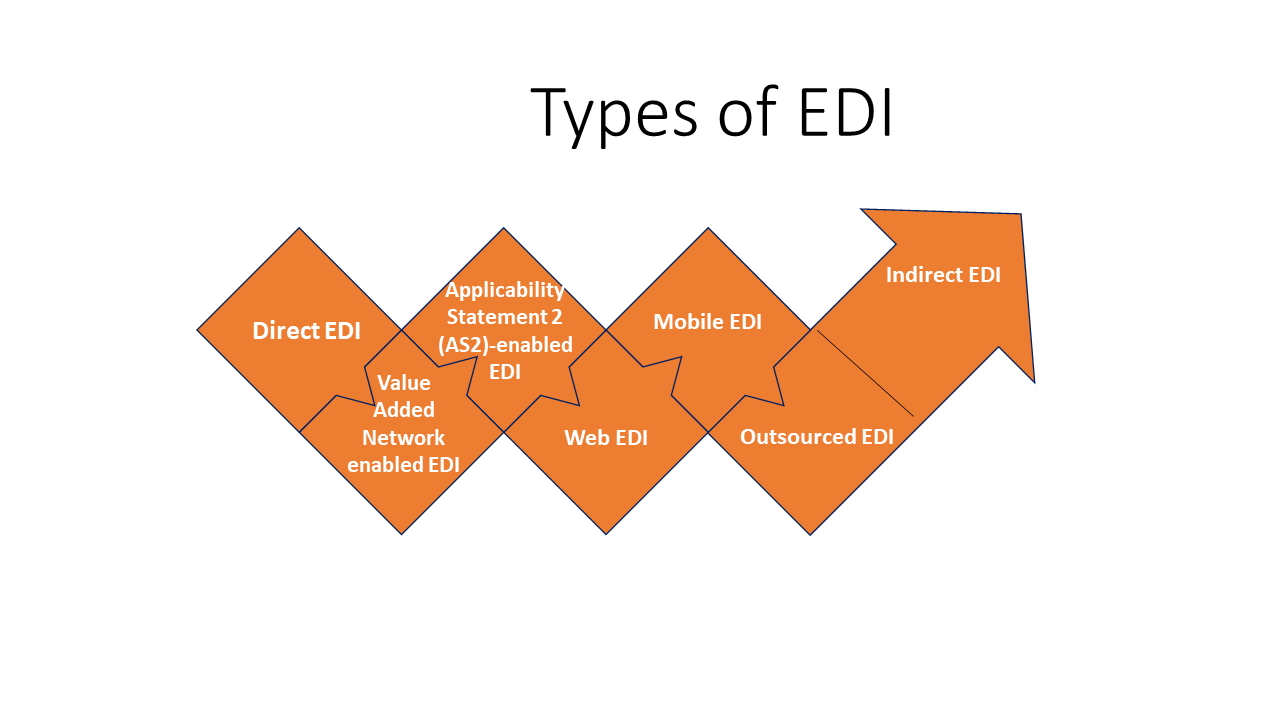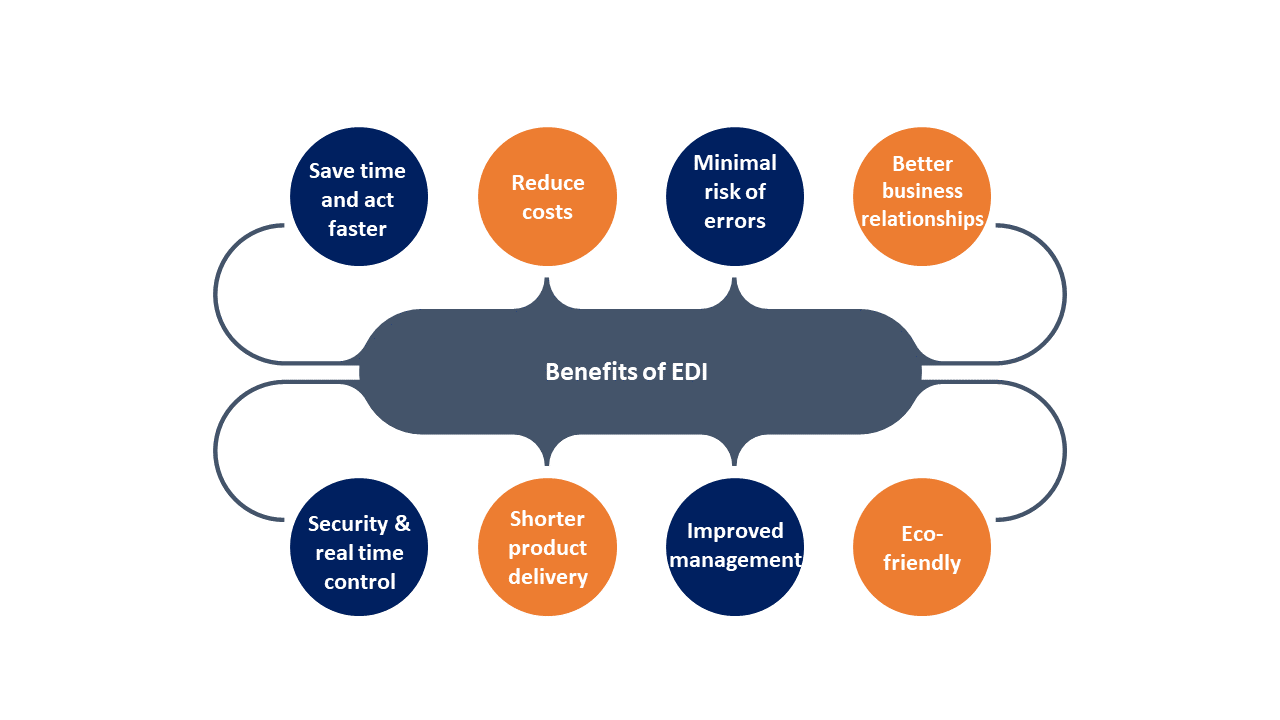Table of Contents
In the era of ever-changing digital landscapes and the rise in the level of interconnectedness, enterprises are slowly becoming aware of the need for effective and secure data sharing. The answer has been EDI, which makes electronic data exchanges fast and precise. EDI or Electronic Data Interchange can be defined as the exchange of business documents between different companies in the same format. To put it simply, EDI is the standard electronic format that has been replacing the role of paper-based documents like invoices and purchase orders. Effective digital tools used by EDI support specialists are necessary in the present corporate environment, which is characterized by a rise in remote work, intricate global supply chains, and larger data quantities. Secure data transmissions are also important because of strict data protection laws. In this situation, EDI distinguishes itself as a strategic asset for companies navigating the digital market, in addition to being an operational instrument.
The future of EDI is exciting and filled with new trends, regulations, and innovations that companies need to adopt to be efficient and competitive. These developments, along with our increased reliance on it, are contributing to the evolution of data transfer systems.

What is EDI and How it Streamlines Businesses
Electronic data interchange is the industry standard format for exchanging business between companies. The EDI market is expected to expand at a compound annual growth rate (CAGR) of 11.6% from USD 1.88 billion in 2024 to USD 4.04 billion by 2029.
By automating paper-based transactions, organizations can decrease errors and save time. Information is transferred straight from one organization’s computer program to another through EDI transactions. The location and sequence of data in a document format are specified by EDI standards. With these automated capabilities, sharing data is now easier and faster than with paper papers or other antiquated techniques that might take hours, days, or even weeks. Compared to using paper papers or other traditional ways, which can take hours, days, or even weeks, sharing data is now quicker and simpler with this automated capacity.
These days, a variety of document types, including purchase orders, invoices, requests for quotes, loan applications, and more, are shared within industries using EDI integration. As part of their supply chains and business-to-business (B2B) networks, these companies are often trading partners that regularly exchange goods and services.
How EDI Streamlines Businesses
With EDI support specialists organizations can streamline time-consuming operations by easily EDI solutions with their current systems, such as Enterprise Resource Planning (ERP) software. More effective order processing, inventory control, and invoice production are made possible by this integration. EDI transactions remain the standard method for exchanging documents and conducting business between large and small enterprises, and they are crucial to B2B procedures.
Moreover, real-time data transmission made possible by EDI-managed services guarantees that all stakeholders have access to correct and current information, improving operational efficiency and decision-making. EDI integration can improve corporate processes in the following ways:
Order processing:
This can involve preparing purchase orders, forwarding bills, and monitoring shipments, among other things. Businesses can increase accuracy and save time and money by automating certain operations.
Inventory management:
Picking and packing slips, shipping receipts, and inventory level tracking are all possible with EDI connectivity. Consequently, companies can decrease stockouts and increase the accuracy of their inventory.
Invoice generation:
With EDI integration methods, the processes of creating invoices, sending them, and monitoring payments can be automated. Businesses save money and time when this is done.
Customer service:
By giving companies access to real-time information on client orders, inventory levels, and shipment status, EDI integration can help to improve customer service. With the use of this data, clients can receive accurate and current information on their orders and any potential concerns can be addressed.
Collaboration:
Effective collaboration is the foundation of successful company partnerships, and EDI integration fosters smooth cooperation between trading partners. By implementing EDI, businesses may communicate vital business data to their partners in a consistent, structured format, reducing the need for human data entry and the possibility of misunderstandings.
Automation:
Organizations can reduce the risk of human mistakes and speed up overall business operations by automating data exchange, which eliminates the need for manual data entry. Businesses may create and execute purchase orders, invoices, and other necessary documents with ease using an EDI connection, which saves time and improves accuracy and productivity.
Stay Away From The Stress of Managing Complex EDI Processes by Partnering With Us
Challenges in EDI Implementation
Over the past few decades, B2B integrations and EDI have come to be synonymous. Thus, it’s often regarded as the ideal method for exchanging data that’s essential to a company. That is not at all accurate, though. In actuality, businesses that depend on EDI find it to be fairly problematic due to its numerous problems and difficulties. The most frequent difficulties businesses run across when utilizing EDI are listed below. This article also addresses solutions for such problems and obstacles. Top EDI companies boost the effectiveness of its B2B integration without having to significantly alter the current IT configuration.
EDI scaling
Although EDI is a widely accepted protocol, are we aware that different trade partners have different requirements for what constitutes a “standard” EDI purchase order?
The document types and business regulations of different trading partners vary, even with the basic protocols of EDI. It can be challenging to add a new trade partner with a different set of transactions to the system. Therefore, in order to manage a heterogeneous set of data rules with multiple EDI protocols, you must carefully scale the scope of your EDI.
Instead of doing it yourself, you can think about outsourcing your EDI program to an EDI service provider in order to grow it. Additionally, it allows your employees ample time to concentrate on important business tasks.
Unreliable Data
Bad data can undoubtedly have an impact on your company. In EDI processes, inconsistent data is inconvenient. Poor data quality is the main issue affecting B2B commercial transactions, according to numerous research.
The potential for errors to occur will only grow as data volume continues to rise. A large portion of faulty data difficulties in EDI are caused by incorrect manual data entry, such as duplicate orders, price disparities, or other purchase-related errors. Manual error detection is costly, time-consuming, and prone to mistakes. This can therefore result in higher expenses, poor choices, and dissatisfied customers.
Problems with Speed
Customers now anticipate reduced wait times due to advancements in technology. Once-a-day transmission may no longer be valuable given the current rate of trade, even if it is a clear improvement over the traditional slow pace of the EDI process.
Since frequent transactions between small enterprises and large organizations support market growth, demand in EDI systems is only expected to increase.
The transmission of documents in real-time is imperative, and you must act now to achieve it. Setting up alerts and notifications to notify people when papers become stuck due to processing issues is helpful.
Transparency
Maintaining visibility and openness throughout the whole supply chain process can be a challenging task. The complexity of supply chain operations will inevitably raise the level of difficulty. Keeping lines of communication open and honest with clients and partners can improve productivity and mutual support.
In a day where businesses are moving to more direct channels of communication with customers and commercial partners, transparency has become even more important. Establishing strong mechanisms to preserve openness amongst participants in EDI protocols may be the best path to supply chain visibility mastery.
Collaboration
Even though EDI has been available for more than a few decades, a lot of organizations still are not using this technology. Additionally, your trading partner may employ an alternative EDI format among those who use EDI services. With so many distinct EDI formats in use, having a solution that converts data into a format your system can comprehend is crucial.
It can be difficult to conduct business with trading partners who have not switched to EDI provider options. However, it’s also not insurmountable because brokers who can convert the data into an acceptable format can be hired.
Get Expert Help to Maximise EDI ROI
How efficient EDI support specialists help in eliminating the challenges
When a Dutch manufacturer sends a purchase order to a Chinese supplier, it is immediately responded to with an electronic document informing the manufacturer that the item is not available. The purchase order is sent right away to a different supplier in Austin, Texas, who verifies the order for the corporation. In a matter of minutes, all of this occurs. That is how essential the deployment of electronic data interchange (EDI) is to the success of businesses.
Is EDI implementation, however, easy? Not at all! EDI implementation challenges are real even if it guarantees consistency and effectiveness across the supply chain process. Nevertheless, with careful preparation and execution, these obstacles will be removed.
Scaling up EDI
It is challenging to ascertain the size and scope of EDI software during deployment due to the wide range of data standards and invoice formats that are available on the market.
Your EDI support services can be scaled in the following ways:
- Make that the business rules of trading partners and a variety of document types can be handled by your EDI support specialists. Up to 100 distinct business rules, comprising data elements, document fields, and business rule-driven validations such as delivery addresses or store numbers, are supported by the majority of trading partners.
- In order to manage three or more trading partners, you must have a direct ERP link with EDI transactions. You can use “swivel chair integration,” which entails manually entering data into ERP through a stand-alone system if you have two or fewer trading partners.
- If you lack the resources to oversee an internal EDI program, outsourcing to an EDI provider may also be a good choice. The management, testing, and partner communication can be handled by a third party.
Effects of faulty data
One of the biggest obstacles to starting with EDI is inconsistent, erroneous, or incomplete data. Issues with faulty data often start at the order level. Inaccurate prices, out-of-stock or discontinued goods, and duplicate orders are common examples of data discrepancies. The majority of these discrepancies arise from manually entering the orders into the system.
Setting up an exception-handling mechanism to alert your team and trading partners about the faulty data before it impacts your ERP system would be the most effective way to handle this problem. With the use of the exception-handling tool, documents containing inaccurate or missing data can be automatically categorized, streamlining the EDI process and cutting expenses.
Problems with Document Processing Speed
Real-time document delivery from your EDI support specialists is possible, but can your ERP process the documents as soon as they are received or prepared for transmission?
Processing documents in real-time is essential these days. You can enable warnings and alerts to keep you informed of any discrepancies if a processing fault affects the flow of your documents. You can set up mailbox imports or immediately forward the documents from the EDI network in real time to give your clients faster, more reliable service.
No Transparency
Transparency between trading partners can be difficult to achieve when dealing with complex supply chain procedures. Despite EDI’s initial purpose of automating document interchange, its value has evolved to include improved inventory visibility as supply chains grow more intricate.
Bulk fulfillment is no longer of importance to businesses. As an alternative, businesses are proactively implementing one-to-one models for trade partner data sharing. In direct-to-consumer models, transparency is crucial to ensuring smooth data flow between the parties. To provide increased system transparency, you can apply new EDI transaction sets. Bill of lading, inventory availability, motor carrier tender, and answer, shipment status message, and package status are examples of other EDI transaction sets.
Incompatibility
Dealing with a trading partner who hasn’t adopted EDI is challenging. It is possible to convince your trading partners to use EDI. You would facilitate your work and enhance the trading partner’s operations by doing this. Since you are looking out for your partners’ best interests, they would be open to doing business with you more.
Occasionally, even the most widely recognized EDI standards could not be adequate for EDI deployment. In these situations, you will require a flexible EDI solution that can manage various business circumstances by your expanding company’s needs.

Key Areas For EDI Support
Before choosing an EDI support specialist and beginning implementation, it’s critical to take into account every facet of your proposed new system to accomplish a fully automated and effective trading partner cycle via EDI. However, because EDI has many facets and affects your supply chain widely, it is simple to forget important details while organizing a change to your document exchange strategy.
Implementation
For all businesses, EDI solution providers are important because it ensures that the company can easily exchange electronic data with their trading partners. The electronic exchange of various business documents like purchase orders, bills, and shipment notifications is using the standard EDI format. This reduces the errors and expenses that can occur in paper-based transactions and gets rid of the problem of manual data entry. EDI implementation process comprises of :
-The installation of EDI infrastructure,
-the creation of a technical link with business partners, and
-the certification of the EDI system to industry standards
Train your employees
EDI training and guiding your employees in the proper and efficient usage of your EDI system. You must give them the know-how and abilities needed to run, manage, and troubleshoot your EDI system. Additionally, you must educate them on the advantages of EDI and the difficulties related to it. Also, analyze the best ways to ensure EDI security and efficient EDI transactions. To help with the EDI training process, you would need to write user manuals, tutorials, or guidelines. You might also need to hold webinars or workshops.
EDI Mapping
EDI mapping is a technology that allows you to manage numerous EDI standards in a single EDI system and convert EDI-specific standards into formats that are readable and understandable by other business tools. An essential part of any operational EDI system in a contemporary, globalized supply chain is EDI mapping.
More than ever, simplicity is key, irrespective of regional or pragmatic variations in the uptake of standard formats. Additionally, the ability of mapping tools to map in both directions offers end-to-end simplicity. Businesses are currently depending on more than ever on data mapping to produce high-quality and effective results. By using mapping with the aid of EDI support specialists, many businesses can avoid these supply chain risks. Here, expert-led EDI mapping connections are always supervised by people who understand exactly what mapping entails.
Back-End Integration
The most difficult and expensive aspect of EDI for many firms is integrating EDI processes with back-end systems, databases, CRMs, and ERPs. Although, it may also be the most beneficial. For many firms, automated workflows that integrate EDI in small business directly into ongoing business activities constitute the optimal EDI configuration.
Back-end integration entails using ports and APIs to integrate EDI with certain systems after mapping and interpreting EDI files to and from those systems. Legacy and traditional EDI systems are woefully inadequate in this regard. Because of these issues with legacy and traditional systems, you should think about using an EDI software solution that is based on a contemporary, API-first architecture.
EDI Compliance
Routine operations like purchase orders, invoices, shipping notifications, and other common company papers are more accurate with the use of EDI. By eliminating paperwork, reducing the amount of human data entry, and speeding up processing times, this greatly improves operational efficiency. However, non-compliance might result in operational disruptions and inefficiency. Errors in an EDI 850, for instance, may result in dispatching wrong orders, necessitating return visits, replacement orders, and all the related expenses and delays. In severe circumstances, persistent non-compliance may disrupt the remainder of the supply chain.
Solve Your EDI Challenges With Out Team of Support Specialists
Ensure Compliance with Industry Standards with Efficient EDI support with A3Logics
EDI compliance is now a strategic tool that greatly increases operational efficiency, strengthens business ties, and provides a competitive edge. It is no longer only a need for conducting business.
Due to its technical nature and industry-specific standards, EDI implementation may appear complicated, but with the correct strategy and resources, organizations can simply navigate this terrain. This entails being fully aware of the particular EDI standards specific to their sector, putting best practices like EDI testing into operation to guarantee EDI compliance, and making use of the knowledge of a reputable EDI solution provider in USA.
A3Logics makes the road to EDI compliance easier. With A3Logics, an EDI implementation partner, organizations can easily leverage the potential of EDI solutions thanks to an all-in-one solution that offers both enhanced EDI functionality and ETL capabilities.
Conclusion
Six decades after its introduction, EDI’s many advantages continue to revolutionize supply chain logistics. With increased uses and EDI investment throughout its growth, the technology has cemented its position as a vital tool for many different industries. Even though EDI has drawbacks (such as implementation costs and the requirement for stronger security measures), it is an essential tool for organizations all over the world.
Implementing EDI can be challenging for certain businesses. Keeping up with the constantly changing regulations, standards, and updates from the government is one of the reasons. Because it must take into account the intricacies of global business needs, it is likewise intrinsically complex. In a B2B network, for instance, each trading partner may have different needs. Because each organization’s formatting requirements are different, many outsource EDI solutions from reliable EDI-managed service providers. Effective EDI implementation requires a few fundamental prerequisites, skills, and resources, whether done internally or externally.






